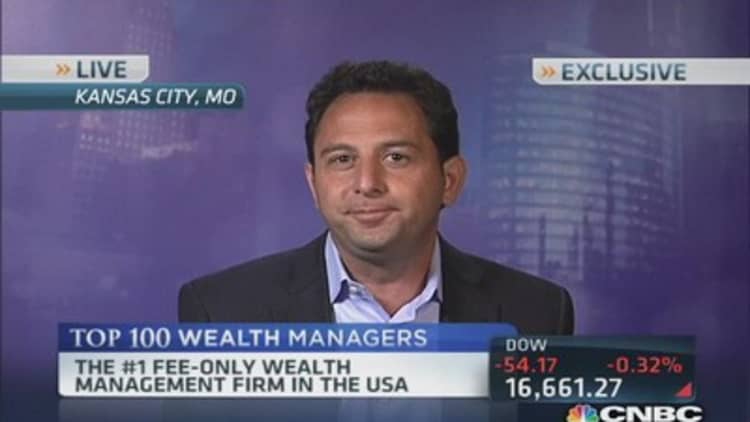The wealth management business seems to break down into a minority comprised of megafirms and a larger grouping of smaller outfits.
On average, teams at these megafirms manage more than $500 million in client assets and control an estimated 42 percent of the industry's overall assets, according to financial-services research firm Cerulli Associates.
These teams have some common features "that typify many of the key trends occurring in the financial advisory industry," according to Cerulli.
First, they operate in teams, with multiple advisors and professional staff, including separate investment managers. This allows financial advisors to break down the various tasks of their workloads and delegate so they can focus on what they do best and enjoy the most, Cerulli explained.
Read MoreTech to drive advisor business
The most successful advisory firms are not about individuals, but teams of people who can offer the client with various services beyond investment strategy, said Philip Palaveev, the owner and CEO of The Ensemble Practice.
"There are not a lot of lone wolves at the top" of the advisory industry, he said.
These megateams consistently target high-net-worth clients, most with more than $10 million in assets. Meanwhile, they charge fees based on a percentage of the client's assets under management, which allows them to focus on clients' goals and how to reach them rather than selling products and collecting commissions, according to Cerulli.
New horizons
The team approach makes sense for ultra high-net-worth clients, who often have complex financial needs that can involve international holdings, family businesses, complicated estate plans and illiquid assets, according to a recent advisor report from independent research firm Morningstar.
Understanding there just aren't enough high-net-worth prospects, financial advisors continue to seek out "smaller investors" to try to expand existing businesses. To be sure, the competition for new clients is steep.
To acquire new clients, smaller advisory firms should look at the 50- to 69-year-old demographic for individuals with investable assets of $2 million to $5 million. This group is nearing retirement, but only 40 percent of them have a formal retirement income plan, according to Cerulli.
Read More'Robo-advisors' stake claim
Another "advice opportunity" comprises the 4.7 million households of people in their 40s with investable assets of $100,000 to $500,000. This group controls more than $1 trillion in assets and is entering its peak earning years.
"Advisors are struggling with a crisis of differentiation," said Michael Kitces, a certified financial planner and director of research for the Pinnacle Group.
"Everyone is selling themselves as a fee-based certified financial planner offering customization," he said.

As more and more people earn their certified financial planner certifications and become financial planners, the mere fact that one is a financial advisor is no longer the differentiator that it once was, Kitces explained.
To that point, advisors are increasingly compelled to focus on a niche practice where it's easier to stand out from the competition and win new clients. Niche practices range from clients who are, say, only doctors or lawyers to those who are widows or same-sex couples.
The savvy advisory firm needs to get up to speed when it comes to technology. Various front- and back-office solutions will lighten the load for advisors while providing consistent high-quality service for clients.
Read MoreWealth management's 'new normal'
"To retain clients, you need to give good service and communicate with them regularly," Kitces said. "Firms need to organize a service that is based on repetitive tasks, like the Starbucks model."
"Technology is raising the bar," said Joel Bruckenstein, founder and president of Technology Tools for Today, which produces practice-management newsletters and conferences for financial advisors. "If I were a millennial, why would I think your services are good if you don't have technology?"
Get a plan
Many smaller firms, however, have not yet leveraged technology to better handle their workload into such standardized tasks, like opening new accounts or automatic portfolio rebalancing.
"Advisors need to understand at every level the mix between technology and personal service," said Alois Pirker, director of research at the Aite Group. To meet the needs of clients, advisors increasingly need to offer a seamless advisor/technology process.
A recent practice-management survey by the Financial Planning Association found that about half of the respondents are still struggling to manage their businesses because they don't know how to codify their procedures.
The single most important question advisors should be asking is, 'Where am I going to be in 10 years?'Philip Palaveevowner and CEO of The Ensemble Practice
To run an efficient practice, these advisors need to develop a clear vision, a serious business plan and an exit strategy. According to the FPA study, 66 percent of advisors surveyed lacked a succession plan.
The shift in business from retiring advisors to a younger generation of successors over the next decade or so will require advisory firms to address the retirement issue or risk losing clients, industry observers say.
Read MoreCNBC names top fee-only wealth managers
The lack of a succession plan could undermine existing clients' sense of security about the future of the firm and lead to attrition, since most advisors have an aging clientele, industry observers say.
"The single most important question advisors should be asking is, 'Where am I going to be in 10 years?'" The Ensemble Practice's Palaveev said. "If you're driving in the wrong direction, the last thing you want to do is drive faster."





